The 1914 Cardinals compiled the best season in franchise history to that point.
- Miller Huggins's second Redbird squad compiled an 81-72 record.
- That was good enough for third place, 13 games behind the pennant-winning Boston Braves and only 2.5 worse than the second place New York Giants.
After three more seasons with St. Louis, Huggins would go on to bigger and better things with the New York Yankees, whom he managed to six pennants and three World Series championships. The strain of dealing with the New York media and a player named Babe Ruth took its toll on his health and he died at 51 - young even for 1929.
A major reason for the '14 Redbirds record-setting season was rookie righthander Bill Doak.
- Doak pitched in 15 games for the Cards in 1913, starting 12 and crafting a 3.10 ERA that was better than his 2-8 record for the last-place club would indicate.
- But he outdid himself the following season, leading the league with a 1.72 ERA. Bill won 19 and lost 6, completing 16 of the 33 games he started and twirling seven shutouts.
- Among his whitewashes was a victory over the Pirates before family and friends at Forbes Field in his native Pittsburgh.
Doak was a deliberate worker who wiped his brown with a large red handkerchief during games.
- He relied on good control and an effective "slow drop" (curveball) to offset the best delivery in his repertoire, the spitball. He had developed that pitch when Huggins, concerned that the frail hurler was expending so much effort in his pitches, suggested he learn to throw the wet one because it required less effort.
- The Sporting News labeled Doak "the only strictly moral man on the Cards." He taught Sunday school before going to the ballpark on the Sabbath.
Bill never enjoyed another season to match his 1914 campaign.
- He came closest in 1920 and 1921.
- His victory total climbed to the magic 20 mark in the first of those two season with an ERA of 2.53 for Branch Rickey's fifth-place Redbirds.
- The next season, the second with the new, tighter-wound ball, saw him win the ERA crown again with a .259 mark. He finished 15-6.
- As he passed age 30, his career wound down. He never won more than 13 games before retiring in 1929 when he was back in St. Louis after three seasons with Brooklyn.
Doak's lasting contribution to the National Pastime was his special glove, which was marketed by Rawlings under his name.
- He approached the company with his idea in 1920.
- The Doak glove included a web laced between the first finger and the thumb. The result was a natural "pocket" to snare balls.
- The design was so revolutionary that Rawlings produced the Doak glove for 31 years starting in 1922. It can truly be called the ancestor of all modern gloves.
Doak still ranks second in career shutouts for the Cardinals with 30, behind only the great Bob Gibson.
Reference: Bill Doak by Steve Steinberg, SABR Biography Project |
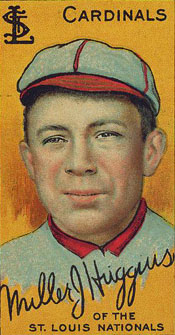
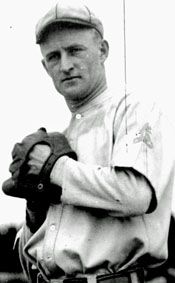
Bill Doak
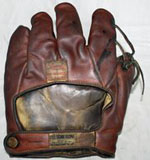
Original Doak glove
|

Eddie Lake
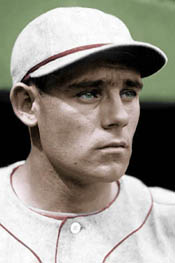
Ray Blades

Billy Southworth
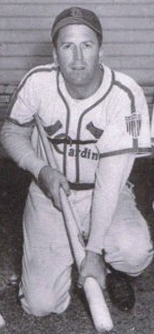
Terry Moore
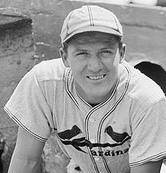
Joe Medwick

Mickey Owen
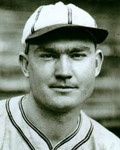
Johnny Mize
|
- January 31 - The Cardinals and Browns jointly announce plans to install lights in Sportsman's Park, which the Browns own. The clubs split the $150,000 cost.
- April 22 - The game at Crosley Field in Cincinnati is nearly postponed by rising flood waters from Mill Creek, which flooded frequently. The water in the dugout was 3' deep when the game began, forcing the players to sit on benches in foul territory. The water kept rising until, by the 9th inning, it had begun to spill onto the field and into the first few rows of box seats. The games the next two days were cancelled because the diamond was underwater.
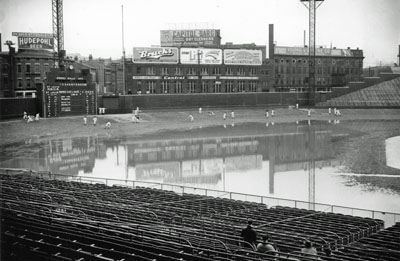
Flooding at Crosley Field
- May 7 - 2B Eddie Lake smacks two HRs as part of an 18-2 rout of the Dodgers that includes seven round-trippers and 49 total bases by the Redbirds. The homers were the first two of Lake's ML career and the only two he hit in 79 games as a member of the Cardinals.
- May 13 - The Cards travel to Cincinnati for a Monday makeup of one of the games lost to the flooding in April. But no umpires show up because the league neglected to assign any. By luck, NL umpire Larry Goetz was at his home in Cincinnati. The game was delayed 29 minutes until Larry could get to the ballpark. Reds coach Jimmie Wilson umpired 1B and Cardinals P Lon Warneke handled 3B. Wilson and Warneke received $50 from the league for their extra duty. The game lasts 14 innings and ends in an 8-8 tie, necessitating a makeup of the makeup game. Although Crosley Field had lights (in fact it was the first ML park to have them), the game was called because of darkness thanks to an ML rule that stipulated that lights couldn't be used to finish day games. (The rule was not changed until 1950.)
After retiring as a player, Warneke served as an NL umpire from 1949-1955.
- June 4 - Seven days after the Browns played the first night game in St. Louis, the Cardinals lose to the Dodgers 10-1 in their first home game under the lights. Thus did the Redbirds become the ninth ML club to play home games at night. 1940 rules in both league limited franchises to seven night games a season. (God forbid this night game nonsense catch on and give working people a chance to attend more games!) A good crowd of 23,500 attended although it was 7,000 short of capacity. The game was held up for seven minutes in the 7th inning while groundskeepers cleared the field of bottles thrown by irate fans. They had become restive as early as the 2nd inning when Pepper Martin was called out on strikes and banished from a game for the first time in his 10-year ML career. In the 7th, Dodgers C Babe Phelps lashed a double to CF but overran the bag and was tagged out. However, umpire Bill Stewart ruled him safe to ignite the glass shower from spectators already irritated by the Brooklyn romp.
- June 7 - Cardinals owner Sam Breadon fires manager Ray Blades and replaces him with Billy Southworth. Criticized at the time, the move would prove beneficial in the long run as Billy led the Redbirds to three straight pennants from 1942 to 1944.
- June 8 - The second bottle shower in less than a week mars the nightcap of a doubleheader loss to the Giants. In the New York half of the 3rd, CF Terry Moore made what fans think is a great diving catch of Babe Young's fly into short CF. But umpire Tom Dunn rules that Moore trapped the ball. The Cardinals protest, and the fans began shouting, then firing hundreds of bottles onto the diamond. Fans in the lower stands are in danger because bottles thrown from the upper deck fall short and smash into the seats and aisles.
- June 12 - The Cardinals shock their fans by trading LF Joe Medwick along with P Curt Davis to the Dodgers for four players and cash. Weary of Ducky's contract demands, the Cardinals front office considered him in decline.
The trade would prove to be one of the worst in St. Louis history. Medwick gave Brooklyn three more good years and made a difference in 1941, when the Cardinals finished second to the Dodgers by 2.5 games. Also, Davis went 13-7 that season.
- June 18 - In his second game for Brooklyn against the Cardinals, Medwick is beaned by Bob Bowman in his first at-bat. Joe suffers a severe concussion. Bowman denies throwing at Ducky intentionally, but no one believed him except NL President Ford Frick, who, after spending several days gathering evience, absolves him of blame. Read more about the incident ...
- June 19 - With tension between the two teams at a high level, Cardinals C Mickey Owen and Dodgers manager Leo Durocher engage in a fistfight that begins with a remark by The Lip as Mickey leaves the field. Frick fines Owen $50 for "conduct tending to incite disorder."
Six months later, Owen would be traded to the Dodgers, for whom he would commit one of the most famous errors in World Series history.
- June 26 - The Cardinals and Giants combine for 13 runs in the 7th inning. After the Redbirds plate seven in the top of the inning to take a 9-3 lead, New York scores six to tie the game on their way to a 10-9 victory in 10 innings.
- September 8 - 1B Johnny Mize hits three consecutive HRs, but the Cards drop a 16-14 slugfest to the Pirates. Mize will finish the season with 43 roundtrippers, which stood as the franchise record until Mark McGwire clouted 70 in 1998. No Cardinal hitter reached the 40-HR mark from 1941-97.
- The Redbirds finish the year in 3rd place, 16 games behind the pennant-winning Reds and four behind the Dodgers.
Reference: Cardinals Journal: Year by Year & Day by Day
with the St. Louis Cardinals Since 1882, John Snyder (2010) |
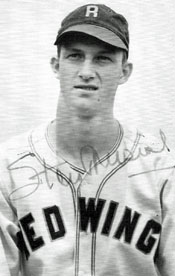
Stan Musial with Rochester Red Wings
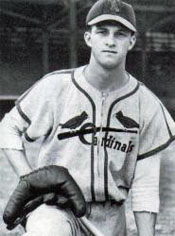
Musial with Cardinals 1941
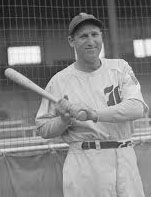
Jim Tobin
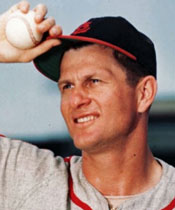
Erv Dusak

Billy Southworth
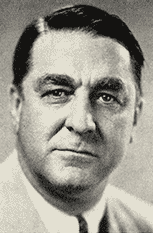
Branch Rickey
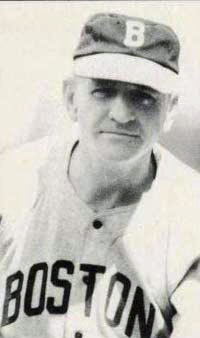
Casey Stengel

Coaker Triplett
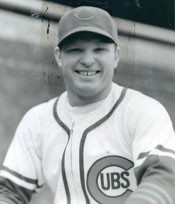
Clyde McCullough
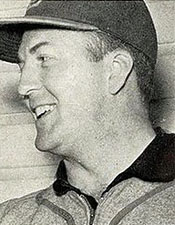
Terry Moore
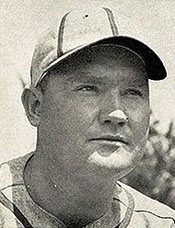
Johnny Mize

Musial and his father Lucasz
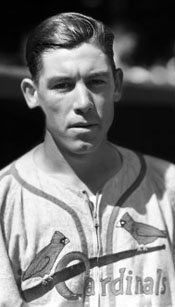
Harry Gumbert
|
Dazzling Debut: Stan the Man
September 17, 1941, is a banner day in St. Louis Cardinals history.
- On that date, Stan Musial made his major league debut.
- The 20-year-old started in RF in the second game of a doubleheader at Sportsman's Park against the Boston Braves.
- Braves manager Casey Stengel started Jim Tobin, a knuckleballer in his fifth season in the bigs.
- Stan popped up his first AB on the first knuckleball he'd ever seen.
From Musial's autobiography: It fluttered up to the plate, big as a grapefruit but dancing like a dust-devil. Off stride, fooled, I popped up weakly ...
- Adjusting quickly, Musial broke a scoreless tie with a two-run double in the 3rd. He also contributed a single to finish 2-for-4 as the Cards won 3-2 to pull within one game of the first-place Brooklyn Dodgers.
Stan: The knuckleball is a challenge, indeed, and I've looked foolish missing my share of knucklers. But I learned to delay my stride, cut down my swing and just stroke the ball.
Stan had started the season at Class C Springfield (MO).
- Converted from pitcher after hurting his left shoulder while making a diving catch, Musial tore up Western Association pitching with a .379 average with 26 HRs in 87 games.
Stan: I never would have made the major leagues as a pitcher. My injury merely hastened a switch that was inevitable.
- His performance at Springfield earned him a promotion all the way to AAA Rochester of the International League, where he hit .326 in 54 games.
Stan: I remember Rochester because I broke in before the home crowd with four hits, including a double and homer, and I remember it even more for offering me the chance to meet Babe Ruth. He came to town to put on a hitting exhibition ... I confess, though, that I was awed - and maybe a little disillusioned - when Ruth sat on our bench during the game, pulled out a pint of whiskey from his pocket and emptied it. I'd wanted to hit one while the Babe was there ... but I managed only one single in five trips against Montreal. The Bambino would have thrown that one back as a minnow.
- Playing RF, Stan helped the Red Wings win 16 of their last 20 games to make the AAA playoffs, but they lost in five games to the powerful Yankees' farm club at Newark.
Musial: For only the second time to my knowledge, Branch Rickey saw me in a regular game when the Rochester club was at Newark. I got four hits that night, part of a tremendous series against a powerful Yankee farm team. In three games I got 11 hits.
- Exhausted from the long season, Stan went back to their hometown of Donora PA where his wife Lil and their infant son had been staying since his move to Rochester. Dead-tired from riding the train through the night, he was taking a nap after Sunday Mass when an excited Lil woke him. A telegram had arrived from the Cardinals ordering him to report to St. Louis for the remaining 12 games of the season. The Cardinals needed Musial because of injuries to veteran outfielders Enos Slaughter and Terry Moore. GM Branch Rickey also purchased 3B George "Whitey" Kurowski, OF Erv Dusak, and P Hank Gornicki from Rochester.
- Stan's in-laws gave him a ride to Pittsburgh where he missed the train but hopped the next one to St. Louis. He admitted in later life that all he wanted to do was not embarrass himself the last two weeks of the season.
- On arrival in the Mound City, he signed his first major-league contract for $400/ month.
Stan: Mr. Rickey hadn't anything particularly memorable to say to me that first morning. It was obvious then, as the Cardinals since have confirmed, that the player on his mind was Dusak, not Musial, and I can see why. Erv was a strapping righthanded power hitter who ran well, fielded well and threw consideably better than I did. Unfortunately, Erv had too much trouble with the breaking ball to last long in the big leagues.
Interestingly, Dusak had also started out as a pitcher.
- Clubhouse man Butch Yatkeman gave the new arrival uniform number 6. Usually, callups got high numbers in the 40s or 50s. Did Stan get a choice number because the club knew he would be a Hall of Famer? No, 6 just happened to be available. No one at the time could have dreamed that the number would one day be the first number retired by the franchise.
Stan's new teammates certainly didn't think of him as anything other than a late-season callup. The first time he tried to get in some swings during batting practice, veteran C Walker Cooper yelled, Get your ass out of there! It wouldn't be long, though, before the newbie gained the respect of his elders. Stan would spend his career being generous and helpful with Cardinal rookies.
Here's the log of Stan's games the rest of the season during the hot pennant race with the Bums.
- September 18: Manager Billy Southworth wrote Musial's name in the lineup in RF again. Stan singled in four at-bats as Manny Salvo scattered six hits in a 4-1 Braves' victory. However, the Dodgers also lost at Pittsburgh 6-5.
A shrewd judge of baseball ability although he hadn't yet gotten a chance to manage a talented team, Boston manager Casey Stengel bragged about Musial at several subsequent stops the remainder of the season. When the Braves played the Dodgers a few days later, he told the Brooklyn writers, You fellas will win it, but those Cardinals got a young kid in left field who you guys are gonna write about for twenty years. He also told rookie reporter Bob Broeg, who grew up in St. Louis: Your club has got a guy with an unusual name. Referring to Musial's first at-bat against Tobin, Casey said, Popped it up. So he threw that dead fish again, and he popped one (a double). He's gonna be a great player.
- September 19: Batting third, Stan went 3-for-3 off Paul Erickson of the Cubs, including a double with an RBI and a walk. The Redbirds won 3-1 to gain a 1/2 game on the idle Dodgers. In the 1st, Stan walked to load the bases as the Cards took a 1-0 lead. Musial also had a hand in the two-run fifth. To quote the AP article, Musial, Branch Rickey's latest farm sensation and almost sure to be a regular outfielder next year, then dropped a Texas league single into short center to score Moore. Musial contributed a double later and since joining the Cards has made six hits in 11 times at bat. Room was made for him in today's lineup by benching big Johnny Mize, who hurt a shoulder in a headlong slide yesterday. Johnny Hopp moved from the outfield to first base.
- September 20: Despite his rookie's perfect day in the opener of the Series, Southworth kept Musial on the bench against lefty Johnny Schmitz. Leading 3-1 heading into the top of the 9th, Lon Warneke blew up. Before the inning ended, Chicago had sent home six. Stan pinch hit for SS Marty Marion in the bottom of the 9th but made the second-to-last out. The loss, coupled with Brooklyn's 3-2 victory at Philadelphia, dropped St. Louis two games behind.
- September 21 (first game): Playing LF and hitting cleanup before a big Sunday crowd of 26,210 that finished the home season with the franchise's best attendance since 1928, Stan hammered four hits, including two doubles, in five at- bats and scored the winning run with a daring bit of base running. With the score tied at 5 and one away in the bottom of the 9th, Musial singled and went to second on an infield out. After an intentional walk, Coaker Triplett hit a roller about 10' in front of the plate. C Clyde McCullough raced for the ball and fired to 1st an eyelash too late. As McCullough watched the first baseman argue the call, Stan didn't break stride around 3rd and raced across with the winning tally.
- September 21 (second game): In the fifth spot in the order and back in RF against southpaw Vern Olsen, Musial closed out a great afternoon with two singles in five trips asthe Cards coasted 7-0 behind Howie Pollet to pull back to a game behind the Dodgers, who split a twinbill in Philadelphia. Stan also showed that he was not just a proficient hitter by making three excellent catches during the doubleheader.
Afterward, Southworth said of his rookie hero, That kid was born to play baseball.
Cubs manager Jimmy Wilson was also impressed. Nobody, but nobody, can be that good.
The next day, Robert L. Burnes wrote in the St. Louis Globe-Democrat: Musial is really the answer to someone's prayer. His terrific hitting since joining the club last week has insured at least two triumphs. He can just about do everything.
On the train to Pittsburgh for the next series, Cardinal captain Terry Moore chatted with Musial. Stan explained that they had actually met during spring training in Georgia when Musial was still a pitcher. It can't be, exclaimed Moore. You're not that kid left-hander. Terry called to Johnny Mize: Hey, John, you won't believe this! Musial is the left-hander who threw up those long homerun balls at Columbus this spring.
Looking back years later on Stan's debut in 1941, Moore said, When I saw him in a Cardinal uniform, I just couldn't believe it. At the start of the season, he is a humpty-dumpty, bum-armed kid pitcher who I tag for a home run, a guy who is almost as low in the pro leagues as you can get. And at the end of the same year, he is a big-league outfielder!
- September 23 (first game): Playing in Pittsburgh, 27 miles from his birthplace and hometown, Stan went hitless in four ABs as he and his mates couldn't solve the lefthanded slants of Ken Heintzelman, a Cardinal nemesis who cruised to a 4-0 victory.
- September 23 (second game): The Cards turned the tables on the 4th-place Pirates in Game Two, 9-0. Stan smacked his first major league HR, a two-run shot in the 5th off Rip Sewell, and also contributed two singles and scored two other runs. The split left Southworth's club 1.5 behind Brooklyn with just five to play.
Stan on his first big league homer: It was quite a thrill to trot around the bases at Forbes Field, where three years earlier I had watched the Pirates as a schoolboy, and to know that Lil, my parents and many friends were watching.
After Musial brought his father Lukasz, who was born in Poland and hadn't approved of his son playing baseball, to the clubhouse and introduced him to his manager, teammates, and coaches. Pop and I may have been shy, but we were two happy, proud Poles that evening. He also added an interesting sidelight to his first homer. The odd part of it is that Steve Posey, a friend of mine from Donora, was sitting in the right-field stands and caught the ball.
- September 24: Lean Harry Gumbert's sweeping curves mesmerized the Bucs batters, who managed six hits but no runs. It took the visitors until the sixth to break out with three runs. Stan's sharp single to CF drove home Johnny Hopp with the first run. It was the only safety for the "sensational rookie" in five atbats, dropping his average to a mere .457. The 4-0 victory allowed the Cards to stay 1.5 in arrears of the Dodgers, 4-2 victors at Boston, but with one fewer day remaining.
P Max Lanier, who with his wife had befriended the Musials, recalled his amazement at what his new teammate was doing. He had a funny stance, but it all unwound when he swung.
- September 25: Stan scored the only run in a 3-1 loss which, coupled with Brooklyn's 6-0 triumph in the Hub City, pushed the Redbirds over the edge of the precipice, 2.5 behind with two to go. Musial's two singles, including a topped roller down the 3B line, accounted for 40% of the Cards' production against exDodger Max Butcher. The Pirates, playing hard for their skipper, former Cardinals player-manager Frankie Frisch, had split the four-game series.
Donora officials organized Stan Musial Day for his last game in Pittsburgh. I really hadn't done anything yet, but they thought I had, just by becoming the first home-town boy to reach the big leagues since Bob Coulson went up in 1908. They declared a school holiday (so they wouldn't have to play hooky), and a delegation presented Stan with gifts, including a traveling bag and money, before the game.
- September 27: Playing out the string at Wrigley Field, the Cards scored four in the 1st but lost 6-5 when the Cubs plated three in the bottom of the 8th. Stan's ledger looked like this: 1-for-4, 1 run, 1 RBI.
- September 28: The Redbirds closed the season with a 3-1 victory. LF Musial, the cleanup hitter, went 1-for-4. The Dodgers took the pennant by 2.5 games.
Musial's ledger for 1941 read like this:
- Games - 12
- Games Started - 11
- AB - 47
- Hits - 20
- Batting Average - .426
- Runs - 8
- RBI - 7
|
- SB - 1
- BB - 2
- SO - 1
- OBP - .449
- SLG - .574
- OPS - 1.023
|
Years later, Branch Rickey commented on Musial's meteoric rise from Class D to the majors in 1941. I went down to see him two different times. He went to Rochester in the International League. He had led the Springfield league. Now he led the International League. I was so intrigued with his kaleidoscopic advance - extra-base hits galore - I brought him into St. Louis at the end of the season, and he led that league, too.
The St. Louis fans and the Cardinals themselves wondered what might have happened if Musial had joined the team earlier.
- Broeg speculated that, if Rochester had not made the playoffs, freeing Stan to join the parent club earlier, the Cardinals would have overtaken the Dodgers.
- Johnny Mize, no fan of the parsimonious Rickey, complained that the Cardinal GM should have brought Musial up sooner. We might have gone ahead and won the pennant.
After the season, Donora honored Stan again, this time with a banquet sponsored by the Donora Zinc Works Athletic Association. He received a wrist watch and a trophy. Western Pennsylvania's greatest hero, Honus Wagner, was there. The old legendary Flying Dutchman of the Pirates and I became good friends. Even in my most fanciful dreams, I never would have dared imagine that I would play long enough and hit well enough to break many of Old Honus' National League records.
In the off season, Branch Rickey made two moves that cleared a spot for Musial in the 1942 lineup.
- October 9 he purchased Stan's contract from Columbus, a Cardinal farm club.
- December 11, four days after Pearl Harbor, Rickey traded Mize, who was unhappy with his contract as usual, to the New York Giants for Ken O'Dea, Bill Lohrman, Johnny McCarthy, and $30,000.
- That allowed Southworth to play Johnny Hopp at 1B and install Musial in LF for 1942 to start a string of three straight pennants.
- When Stan reported for spring training in 1942 prepared to play for $400 a month, Rickey tore up the previous contract and gave him one for $700 per month.
|
References: The Man Stan: Musial, Then And Now ... As Told to Bob Broeg (1977)
The Spirit of St. Louis: A History of the St. Louis Cardinals and Browns, Peter Golenbock (2000)
Stan the Man: The Life and Times of Stan Musial, Wayne Stewart (2010)
Stan Musial: An American Life, George Vecsey (2011) |
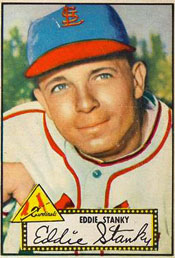
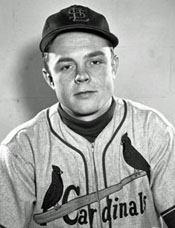
Earl Weaver
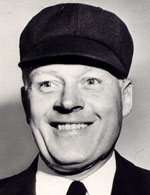
Scotty Robb
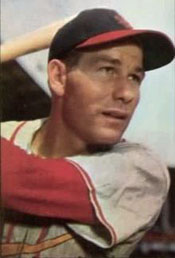
Solly Hemus
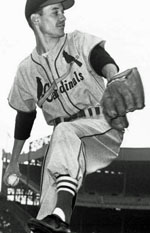
Stu Miller
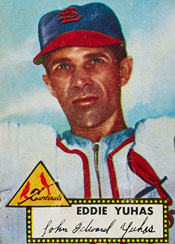
|
Any baseball season has its unusual occurrences. Here's some from the 1952 Cardinals season.
- Spring Training - 20-year-old P Bobby Slaybaugh is struck in the face by a line drive during spring training in St. Petersburg FL. The ball shatters his left cheekbone and knocks the eyeball partially out of its socket. As a result, the eye is eventually removed. Slaybaugh pitches in the minors three months later but never makes it to the big leagues.
New manager Eddie Stanky tries himself at 2B with veteran Red Schoendienst moving to SS. When it becomes apparent that Eddie has lost a step, the Cardinals give 21year-old St. Louis native Earl Weaver a shot at the keystone sack. However, Earl returns to the minors before Opening Day.
Although he never appeared in a ML game as a player, Earl will make the Hall of Fame as manager of the Baltimore Orioles.
- April 15 - The Cards open the season at Sportsman's Park with a 3-2 win over the Pirates before 15,850. During the offseason, Bill Veeck, owner of the Browns and therefore of Sportsman's Park, installed photo murals of his players behind the concession stands. When the Cardinals play at home that year, owner Fred Saigh covers the murals with red cloths.
- April 22 - Home plate umpire Scotty Robb ejects Cardinals SS Solly Hemus for throwing his bat after being called out on strikes. Stanky rushes to Hemus's defense and brushes Robb's coat while arguing with him. Robb throws his mask aside and gives Stanky a vigorous shove and even seems ready to go to blows. NL President Warren Giles fines Stanky $50 but also docks Robb's pay by twice that amount.
An NL ump since 1947, Robb sends Giles his check and letter of resignation. A few days later, AL President Will Harridge hires Robb. But after less than two months in that league, Scotty retires for good at age 46 to devote his time to his printing business.
- April 29 - Union bartenders picket Sportsman's Park to protest the employment of non-union concession-stand employees. Electricians in charge of the lights at the stadium refuse to cross the picket line. Negotiations result in the removal of the picket line, and the game against the Brooklyn Dodgers begins 65 minutes late.
- May 28 - Stanky fines veteran P Harry Brecheen $50 for failing to make a pitchout that the manager signaled. Two days later, Stanky has a meeting with his rebellious team to clear the air. He lifts the fine against Brecheen and eliminates all automatic fines. The Cardinals respond by winning 28 of their next 40 games after starting the season 17-21.
- June 1 - The Cards win the first game of a doubleheader over the New York Giants 8-7 at Sportsman's Park. The second game is called after 7 1/2 innings with the Redbirds leading 8-2 because of darkness. A NL rule prohibits lights being turned on to complete games played on a Sunday.
- June 15 - St. Louis sets an NL record (since tied) by coming back from an 11-0 deficit to defeat the Giants 14-12 in the first game of a DH at the Polo Grounds. Apparently, the Redbirds used up all the hits in their bats in that contest because lefty Dave Koslo shuts them out 2-0 in the second game, called after seven innings by darkness due to the same NL rule cited above.
- August 12 - Crafty righthander Stu Miller makes his ML debut with a 1-0 win over the Cubs at Wrigley Field.
- August 17 - Miller comes within one out of pitching another shutout, beating the Reds 2-1 in St. Louis. The run scores on back-to-back errors by Hemus. Play is suspended for several minutes in the 6th ining when fans toss bottles and paper into LF to express their displeasure with umpire Bill Stewart's out call at the plate that cost the Cards a run.
This incident and others like it would lead to beverages being sold only in cups, not bottles, during the '53 season when the Cardinals are the sole tenants of Sportsman's Park, the Browns having moved to Baltimore.
- August 22 - Miller is again brilliant, besting the Giants 3-1 at Sportsman's Park. The lone NY tally in the 8th ends Miller's streak of no earned runs in his first 25 innings in the majors.
- August 27 - Umpire Lon Warneke (who once pitched for the Cardinals) clears the St. Louis bench of everyone except manager Stanky after the Redbirds refuse to stop heckling the umpires following C Del Rice's ejection in the 3rd inning. The umps allow Stanky to bring players back one by one as needed.
- September 4 - Miller twirls another shutout, 1-0 over Chicago at Sportsman's Park. He will finish the season with a 6-3 record and a 2.05 ERA in 88 innings.
However, Stu will be unable to duplicate that effort in 1953 and '54, with ERAs over 5.5 both seasons. As a result, the Cardinals send him to the minors during the '54 season and eventually trade him to the Phillies. Miller crafted a 16-year ML career primarily as a relief pitcher.
- September 9 - Stan Musial cracks his 2,000th career hit with a single off Curt Simmons in the 4th inning of a 7-4 victory over the Phillies in Philadelphia.
- September 14 - The Redbirds score 11 runs in the 5th to break a 3-3 tie and defeat the Giants 14-4 at the Polo Grounds. Musial smacks a double and HR in the big inning. The victory breaks a 13-game losing streak to Dave Koslo dating back to 1950.
- September 16 - The Cardinals play the Braves in Boston for the last time, sweeping the DH 8-6 and 5-1.
The Braves will move to Milwaukee for the 1953 season.
- September 25 - Rookie sensation Eddie Yuhas wins his 10th game in a row, 4-3 over the Reds in St. Louis.
The 27-year-old righthander will hurt his arm during spring training in 1953 and pitch in only two more big league games.
- September 28 - On the final day of the season, Musial makes his only appearance as a pitcher in a big league game. With a .336 to .326 lead over the Cubs' Frank Baumholtz in the NL batting race, Stan toes the rubber against Baumholtz with one out in the 1st inning. P Harvey Haddix goes to CF for this one batter. A switch-hitter, Baumholtz hits a weak grounder to Hemus, who bobbles the ball for an error. Stan then returns to CF for the rest of the game. At age 31, he leads the NL in batting average (.336), runs (105), hits (194), doubles (42), slugging % (.538), and total bases (311).
The '52 Cardinals finished in 3rd place, 12.5 games behind the Dodgers and 8 behind the Giants.
References: Cardinals Journal: Year by Year & Day by Day with the St. Louis Cardinals Since 1882, John Snyder (2010) |
2015 brought Ted Simmons' election to the Cardinals Hall of Fame by a vote of the fans.
- Ted caught for St. Louis from 1970 through 1980.
- A rare switch-hitting backstop, he played in parts of 21 ML seasons for three different teams, compiling 2,472 hits and a lifetime average of .285.
An all-state football star at Southfield High School in Highland Park, Michigan, Ted received scholarship offers from Michigan, Purdue, Michigan State, and Colorado.
- When the Cardinals selected Ted in the first round (tenth selection) in the June 1967 free-agent draft and offered him a $50,000 signing bonus, the 18-year-old forsook football for the diamond.
- In 1968, he tore up the Class A California League, hitting .331 with a .570 slugging % thanks to 30 doubles and 28 homers. He drove in 117 runs in 136 games to earn the league's Rookie of the Year and MVP awards.
- Moved to Tulsa of the AAA American Association in 1969, he kept on hitting: .317 with 33 doubles, 16 HRs, and 88 RBI.
- The trade of C Tim McCarver to the Phillies before the 1970 season opened up a spot behind the plate of the parent club for Simmons.
McCarver believes there was an ulterior motive behind the Cardinals' sending him to Philadelphia. One reason for the trade, I'm convinced, is that I had begun to get active with the Players' Association. I was the Cardinals' player representative, and I had a few run-ins with the brewery that owned the team (Anheuser-Busch) ... Another reason was that they had a young catcher coming through their system who they thought was going to be a star, and they wanted to make room for him. The catcher's name was Ted Simmons. He was a "can't miss" prospect, a switch-hitter and, man, could he hit.
- Sharing catching duties with veteran Joe Torre, Ted appeared in 82 games and hit .243.
Cardinals ace Bob Gibson wasn't impressed by Simmons' work behind the dish. Bob wrote in his autobiography: Replacing McCarver wasn't much easier. I suppose I'd been spoiled over the years by his understanding of the game and of my pitching methods ..., and when Simmons took his place behind the plate it was like the first day of school all over again. He had no clue about what I was trying to accomplish out there. I had to shake him off the first five or six pitches. Finally he called time, ran out to the mound, and said, "Are you trying to give me a hard time?" I said, "Ted, I'm trying to win the ballgame. You're just sitting back there putting fingers down." He was calling a game the way you would in Little League - strike one fastball, strike two fastball, strike three curveball. I don't think he even knew about my slider, which was my best pitch. It seemed to me that Simmons was preoccupied with getting his base hits - which, I should add, has its place. I certainly appreciated offense.
In 1971, Simmons caught the only no-hitter that Gibson pitched in his career. Bob doesn't mention that fact in his recounting of the game.
Ted had been taught to switch-hit by his older brothers.
- However, he never felt fully comfortable with it until he reached the majors.
- I almost quit [switch-hitting], he recalled, but Kenny Boyer and Red Schoendienst (his first managers with the Cardinals) saw something in my swing and told me that I'd eventually come out of it if I stayed with it.
- Three times during his career, he hit homers from both sides of the plate in a game. He would catch more games than any other switch-hitting C - 1,771 compared to second-place Wally Schang's 1435.
- Switched to 1B later in his career, Ted boasted that he could play that position right- or left-handed.
Simmons drew mixed reviews for his work behind the plate.
- On the one hand, he gave up 182 passed balls, the modern day record, and threw out only 34% of runners trying to steal.
Respected baseball historian Bill James on Simmons: The decision to make a catcher out of him can be questioned. James noted that Ted might have amassed 3,000 hits had he played another position. (He had 2,472.)
- But he was also known as an accomplished handler of pitchers.
Reliever Clay Carroll, who pitched for the Redbirds in 1977 after eight seasons throwing to Johnny Bench in Cincinnati, praised Simmons. To me, he's a real good defensive catcher. He knows what he's doing back there. I don't have to shake him off that much. When I'm not throwing right, he comes out right away and lets me know about it. And he reminds me what to do in certain situations. I really have confidence in him. All he does is give the sign, and I throw it."
McCarver seconded Carroll's opinion of Simmons. Defensively, he wasn't a great technician, but he was very intelligent and a good handler of pitchers.
- Ted made the All-Star team eight times with the Cardinals.
A fierce competitor, Simmons became more and more frustrated during his ten years in St. Louis.
- After winning three pennants in five years (1964-68) just before he came to the club, the Redbirds never won during the decade of the '70s.
- They finished second in the NL East three times, third three times, and fourth and fifth twice each.
The offense of the 1973 Redbirds has been described as Lou Brock getting a base hit, stealing second, and Simmons knocking him in.
Ted led the club in RBI's that year with 91, 22 more than Joe Torre.
- Ted philosophied: Winning. That's what I want. That's all there is. You can't think like, "Maybe I'll go to Cincinnati and do it there." I can't go to the front office and say, "Hey, you gotta get better players." It's tough enough just being a player. I just have to keep playing and worry about myself.
- He became a target of the boo birds, which led him to complain, Too many of them don't know what's going on, a comment that didn't endear him to his detractors.
- However, overall, he was a fan favorite and, most years, the Redbirds' biggest offensive threat.
Simmons's tenure in St. Louis reached a low point in 1977 when Vern Rapp took over the club after Red Schoendienst was dismissed for being too soft on his players.
- Rapp had earned a reputation in the Reds minor league system as a martinet. He ordered Simmons and others to lose weight and instituted a rule against drinking in the hotel bar on the road. He also banned beards and mustaches. That affected Ted, who had gained the nickname "Simba" because of his long hair.
- The team suffered through 1977, finishing 3rd at 83-79. But matters reached a breaking point early in the '78 campaign following an incident involving Simmons.
- After the Cardinals lost a 10-inning home game to the Phillies April 15, Ted turned up the music on the clubhouse stereo in an attempt to loosen a tense atmosphere. Rapp interpreted this as evidence that Ted was indifferent to defeat. The two argued so loudly behind closed doors that Rapp could be heard calling his C "a loser."
- Though Rapp eventually apologized, he had lost the respect of his players, who saw Simmons as a leader who played hard.
- When the record reached 6-11, Rapp was canned, replaced by former Cardinal 3B Ken Boyer.
An incident later that season illustrates Simmons's frustration with losing.
On May 27, the Cubs came to Busch Stadium riding a six-game winning streak. Upset by his club's 15-29 record, Ted jawed with home plate umpire Paul Runge all evening. He seemed to be uptight through most of the game, Runge told the Associated Press. Before the 7th inning, I was joking with him and telling him to relax. There was something working on him. The Cubs brought in closer Bruce Sutter to preserve the 2-1 lead. Leading off the inning after doubling and tripling earlier in the game, Ted crushed an 0-2 pitch for his only homer off Sutter in his career. As Ted stepped on home plate, he tipped his cap to Runge and said, "Take that." He definitely showed me up, but he didn't cuss me, said Runge. It was a perfect opportunity for him, and he took the opportunity. Runge booted Simmons, and the Cubs scored a run in the 11th to win the game.
The Cardinals filed a protest with the league, arguing that Ted should not have been ejected. Boyer: I think this has been ... brewing over a long period of time, but unless you call an umpire a name, he shouldn't be kicked out. ... The only job Runge had was to see if Ted touched the plate. I don't think the average fan knew they were having words before. Teddy never once turned around.
Ted was a workhorse for the Cardinals through 1980.
- He hit .303 or better six times, with a high of .332 in 1975. In 1975, he collected 188 hits as a C, just three shy of Yogi Berra's 1950 catcher's record.
- He drove in over 90 runs six times, topped by 103 in 1974 when Lou Brock stole 118 bases and scored 105 runs and Bake McBride registered 30 thefts and crossed the plate 81 times.
- Simmons even played 40 games in LF or RF during his stint at Busch Stadium.
Ted's career with the Cardinals took a turn when Whitey Herzog took over as GM/ manager during the 1980 season.
- Ted didn't see eye to eye with his new manager.
Herzog didn't like the team he inherited. I've never seen such a group of misfits, he said at the time. Later, he recalled: Nobody would run out a ball. Nobody in the bullpen wanted the ball. We had guys on drugs and another guy who sneaked off into the tunnel between innings so he could take a hit of vodka.
Whitey wanted more speed on his team that would play half its games in cavernous Busch Stadium II with its artificial turf.
- Whitey stole the show at baseball's winter meeting in December 1980 when he started remaking his new club.
- He traded 13 Cardinals and received nine players in return in three deals. The biggest stunner was the last one: Simmons, "the soul of the team," was traded with P Rollie Fingers and Pete Vuckovich to the Brewers for P Lary Sorensen and Dave LaPoint and OF Sixto Lezcano and David Green.
- Having signed free agent Darrell Porter, who had anchored his Kansas City teams from 1975-79, Herzog had planned to move Simmons to 1B to replace Keith Hernandez, who would play LF. Initially, Ted said playing 1st was "just fine" with him. But after further consideration, he asked to be traded. You're taking a Gold Glove (Hernandez) and putting him at a position other than where he might win it.
- The loss of Simmons provoked the biggest outcry from Cardinal fans. Herzog explained the trade. I didn't want to make it. I was forced to trade him ... I couldn't have both him and Porter as catchers. I didn't have to trade him, but it would have led to a bad situation if he wasn't happy ... We've improved our defense. We've improved our team speed.
The Simmons deal worked out well for both teams.
- After a subpar first year in 1981 as he adjusted to AL pitching, Ted helped the Brewers capture the pennant in 1982. He drove in 97 in an offense dubbed "Harvey's Wallbangers" after Harvey Kuehn, whose ascension to the managerial post at the beginning of June started the club on its rise to the top.
The Brewers began 1982 as a favorite for the AL East flag but got off to a 2324 start. That led to the dismissal of manager "Buck" Rodgers. After the firing, Rodgers was quoted as saying his firing was the result of some "cancers on the team." Reporters singled out Simmons as one of Rodgers' biggest critics.
- Wouldn't you know it - the Brewers met the Cardinals in the World Series and lost in seven games.
- Ted played two more seasons in Milwaukee before finishing his career with the Braves through 1988.
- When he retired, Simba was the NL's career switch-hitting HR king. (Chipper Jones owns that distinction now.) Simmons's RBI total is fifth all-time among switch hitters.
- Critics constantly cite Ted's subpar ability behind the plate. But his career fielding percentage of .987 is exactly the same as Johnny Bench's.
After his playing career, Simmons continued in baseball in various capacities.
- The Cardinals hired him as director of player development after the 1988 season.
- In February 1992, he became Pittsburgh's GM. Ordered to cut costs, Ted slashed the payroll from $35M to $24M, losing much talent in the process. As a result, the Bucs went from three straight NL East championships (1990-92) to 5th in 1993, starting a streak of 26 straight losing seasons.
- A heavy smoker, Ted suffered a heart attack in June 1983 that caused him to resign as Pittsburgh GM.
- He has since served as Director of Player Development for the Padres, a scout for the Indians, bench coach for the Brewers and Padres, and an adviser to the Seattle GM.
- Ted rejoined the Braves in October 2015 as a scout.
Some say Simmons deserves consideration for the Hall of Fame. Here are his statistics compared to the most recent catchers who have earned induction into Cooperstown.
| Player |
G |
H |
R |
RBI |
2B |
3B |
HR |
BA |
Slg% |
| Johnny Bench |
2158 |
2048 |
1091 |
1376 |
381 |
24 |
389 |
.267 |
.476 |
| Gary Carter |
2296 |
2092 |
1025 |
1225 |
371 |
31 |
324 |
.262 |
.439 |
| Carlton Fisk |
2499 |
2356 |
1276 |
1330 |
421 |
47 |
376 |
.269 |
.457 |
| Ted Simmons |
2456 |
2472 |
1074 |
1389 |
483 |
47 |
248 |
.285 |
.437 |
|
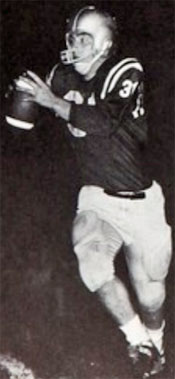
Ted Simmons, Southfield football
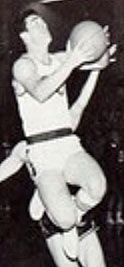
Ted Simmons, Southfield basketball
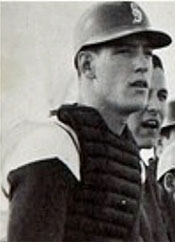
Ted Simmons, Southfield baseball

Tim McCarver
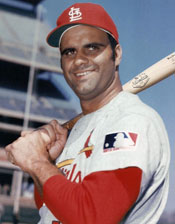
Joe Torre

Simba Simmons
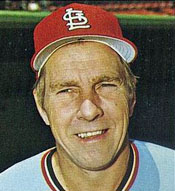
Vern Rapp
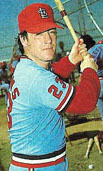
Simmons with locks shorn for Vern Rapp
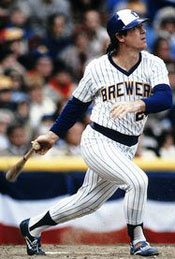
Simmons as Brewer
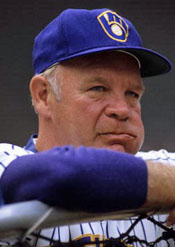
Harvey Kuehn
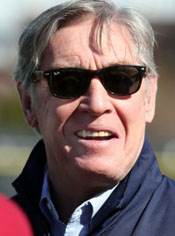
Simmons as advisor with Seattle
|
References: Baseball: The Biographical Encyclopedia, ed. David Pietrusza, Matthew Silverman, Michael Gershman (2000)
Stranger to the Game: The Autobiography of Bob Gibson, Bob Gibson with Lonnie Wheeler (1994)
The Spirit of St. Louis: A History of the St. Louis Cardinals and Browns, Peter Golenbock (2000)
Few and Chosen: Defining Cardinal Greatness Across the Eras, Tim McCarver with Phil Pepe (2003) |
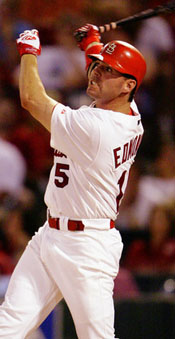
Jim Edmonds
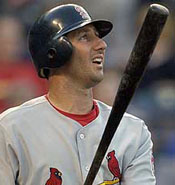
John Mabry
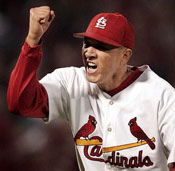
Julian Tavarez |
On May 2, 2005, the Cardinals trailed the Reds 9-3 heading into the top of the 9th.
- Two four-run innings had propelled Cincinnati.
- In the 6th, Ken Griffey's HR, a sacrifice fly, and a two-run double off Chris Carpenter overcame a 3-1 Redbird lead.
- The home team seemingly put the icing on the cake in the 8th. Adam Dunn homered and Joe Randa doubled to knock out Carmen Cali. Rich Aurilia doubled off Jimmy Journell plated another run. Journell rallied and got two strikeouts, but two walks and a single brought home two more.
Righty David Weathers took the mound to preserve the victory for starter Eric Milton.
- C Yadier Molina drew a walk.
- Abraham Nunez, who had pinchhit earlier and stayed in at 3B, also worked a free pass.
- Leadoff man David Eckstein, the SS, singled to load the bases.
- Roger Cedeno pinch hit for P Randy Flores and took a called third strike.
- 1B Albert Pujols grounded into a 6-4 forceout, Molina scoring to make it 9-4.
- LF Reggie Sanders lined a single to LF. Nunez scored, and Pujols stopped at 2nd.
- Closer Danny Graves, another right-hander, replaced Weathers. CF Jim Edmonds walloped a 1-1 pitch over the RCF fence to make it 9-8.
- 2B Mark Grudzielanek reached 2nd on an error by 1B Sean Casey.
- RF John Mabry clouted the first pitch out of the park to give the Cards a 10-9 lead.
- Batting for the second time in the inning, Molina got an infield hit.
- Nunez also got a hit to 2B.
- Graves finally retired the side by getting Eckstein to fly to RF. It was his first blown save in nine tries.
Julian Tavarez took the mound to save the game.
- Randa lined a single to LF.
- Aurilia bunted in front of the plate, and Molina threw the baserunner out at 2nd.
- Tavarez hit C Jason Larue with a pitch to push the tying run to 2nd.
- RF Austin Kearns hit a grounder to Eckstein, who stepped on 2nd and threw to 1st for a game-ending DP.
The victory was one of an even 100 for the '05 Redbirds - the most victories in the majors.
- They waltzed to the NL Central championship by 11 games over the Houston Astros.
- But after sweeping the Padres in the NLDS, they lost to the Astros in six games - a bitter ending to an outstanding season.
|
From 1965-71, the Cardinals had two future Hall of Fame pitchers on their roster - one righthanded and the other a southpaw.
- The righthander, of course, was Bob Gibson, who won 251 games for the Redbirds in a career that spanned 1959-1975.
- The lefty was Steve Carlton, who compiled a 77-62 record with St. Louis, including a 20-9 campaign in 1971.
But Carlton was traded in the offseason before the '72 season in what undoubtedly ranks as the worst deal St. Louis ever made. And therein lies an interesting and, for Cardinal Nation, sad tale.
- Steve was an introverted, skinny lad who started lifting weights at age 14 because "I had the arms of a healthy 8-year-old girl."
- By his senior year of high school, he had decided that he didn't have the grades for college and that his best bet for success lay with baseball. I considered it as a means to an end ... an outlet for survival.
- While attending Miami Dade Junior College, Carlton flew to St. Louis for a tryout in front of Cardinals' pitching coach Howie Pollet. The stylish lefty from New Orleans was so impressed with young Steve that he offered to pay the kid's signing bonus out of his own pocket.
- Steve signed with St. Louis for $5,000 in October 1963 and started the next season at Rock Hill (SC). He finished the season at AA Tulsa.
- Cardinals' minor league pitching coach Barney Schultz said of the lanky southpaw, If I had to pick the next big winner in the major leagues, it would be Carlton. If he ever becoems aware of just how good he can be, he'll be a great one.
- Minor-league pitching instructor Clyde King commented on Carlton's perfectionism. He's the determined type. He probably wouldn't be satisfied with a perfect game. He'd say he threw too many pitches.
- The parent club called him up in September in both 1965 and 1966. He made the 1967 Cardinal roster and never again toiled in the minors.
At age 22, the tall left-hander actually led the Cardinals in victories with 14 during their World Championship season of 1967. That distinction is tainted by the fact that Gibson pitched in only 24 games because of a broken ankle.
- Steve comported himself well in his Game 5 World Series start, allowing only three hits and one unearned run in six innings of work. The Cards nevertheless lost 3-1 to Jim Lonborg.
- Steve went 13-11 in 1968 but pitched only four innings in relief in the Series loss to the Tigers.
- CF Curt Flood remembered Carlton as a Nervous Nelly. Steve Carlton was always certain that each inning would be his last. "I haven't got it," he would moan to me on the bench while our side was at bat. "I'm shot. I'll never make it. They better take me out." I used to give him the old Knute Rockne. "Goddamnit, Carlton, you gotta hang in there. You're all we've got. Now get your ass in gear and earn your money." And he would drag his miserable self to the mound and throw the best left-handed stuff since Koufax, dying with every pitch.
- Nelson Briles on Carlton: He was a high-strung guy but also a fierce competitor. The attitude of the pitching staff rubbed off on him as well. It's what all the young pitchers took away from pitching in St. Louis. The team was competitive, and that had to rub off on you.
- Gibson recalled Steve as a tall, promising, extremely confident southpaw ... whose style of pitching was similar to mine. I thought Carlton might benefit from my experience and relative wisdom, but when I approached him in that vein it seemed that he had little respect for either (although he later acknowledged that he learned a lot about pitching from quietly observing me).
- Carlton caught the baseball world's attention September 15, 1969, with a 19strikeout performance against the New York Mets in a game that he lost 4-3 thanks to two two-run HRs by Ron Swoboda. Once I had nine strikeouts, I made up my mind I'd try to go all the way with it. I kept challenging everybody. It cost me the ball game. In his next start, he fanned 16 Phillies but lost that game also. His 2.17 mark was good for second place in the NL ERA race that year.
- After the 1969 season, Carlton clashed with owner August Busch over a new contract. I don't give a damn if Carlton ever pitches another baseball for the Cardinals, said Busch. They compromised on a two-year $90,000 deal, but the seeds had been sown for Steve's eventual departure.
After a disappointing 10-19 record in 1970, Carlton became the Birds' second-best P in'71.
- Steve on entering '71: I need to redeem myself. I wasn't mentally ready.
- Briles: Steve didn't develop the slider until his last year in St. Louis. He was a fastball, curveball pitcher and didn't enjoy the success he was to have until he added that Sparky Lyle-type power silder, and shoot, he won four Cy Youngs after that.
- He won 20 and lost only 9 with a 3.56 ERA. He struck out 172 and walked only 98.
- Compare that to Bob Gibson's stats that year: 16-13, 3.04, 185 K, 76 BB.
But Carlton had off the field issues that contributed to Busch's dislike of him.
- Peter Golenbock: Carlton was not your normal guy. Communicating with him was not always easy. On the mound, he would tune out all distractions. Off the mound, he did the same. If he considered you the distraction, he'd direct at you an icy stare. Teammates considered him to be a recluse. He hated to sign autographs. He refused to talk to reporters for long stretches at a time. He was devoted to the martial arts. He studied Far Eastern religions. He was a wine connoisseur. He pissed people off with his standoffishness and arrogance.
- After his outstanding '71 season, Steve angered Busch again by demanding $10,000 more than the club offered him for 1972. Since President Nixon had ordered wage and price controls for the nation with raises capped at 5.5%, Busch told his strong-willed lefty that it was his patriotic duty to sign the contract he was offered.
- Carlton: I said, "Here I am. I want to be paid like a 20-game winner." Augie Busch became very angry. He was very demanding, he was pounding on the desk and doing all the tyrannical things. But I decided to hold my ground.
- As spring training approached, Busch ordered GM Bing Devine to either persuade the southpaw to sign or trade him.
- Devine: He was being very difficult to sign for the ridiculous amount of $10,000 between what he wanted and what we'd give him. Many times Mr. Busch gave me a little leeway in the budget, but in the case of Carlton, Mr. Busch developed the feeling that Carlton was a "smart-aleck" young guy, "and I'm not used to having young smart-alecks tell me what to do." Frequently Mr. Busch and I would have conversations where he'd say, "Have you got Carlton signed yet? If you haven't got him signed, figure out what you're going to do with him." I was hoping to get through this and not have it develop into a major issue. Finally I began talking to clubs ... And one of the people I talked to was John Quinn of Philadelphia. John Quinn said, "I think we'd be interested in Carlton." ...
One morning the phone rang. It was Dick Meyer[executive vice-president of the Cardinals]. He said, "What have you done about Steve Carlton?" I said, "What do you mean?" Dick said, "Do you have a trade you can make for him, something you want to talk to us about?" I said, "Yeah, I think I could probably make a deal with the Phillies. Why?" So Dick said, "I'm tired of putting up with that and having my ulcer act up, so my best suggestion to you is that you do me a favor and trade him today."
So February 25, 1972, Devine executed the deal: 26-year-old Carlton to the Phillies straight up for righthander Rick Wise.
- The irony was that the Phillies gladly parted ways with Wise because he embroiled in a salary dispute as well, asking for $65,000. He signed with St. Louis for $60,000.
- Wise, who had compiled a 75-76 record with the Phillies, would pitch only two seasons for St. Louis. He went 16-16 in 1972 with a 3.11 ERA and 16-12 the next year with a 3.37 ERA. After the '73 season, St. Louis traded Wise and OF Bernie Carbo to the Red Sox for OF Reggie Smith and P Ken Tatum.
- Carlton made an immediate impact in Philadephia. In 1972, he won 27 games on a last-place team that came out on top only 59 times.
- Lefty put up 241 W's in 15 years with the Phillies with an ERA of 3.09, which was only .01 less than his ERA with the Cardinals in seven years.
- Devine recalled talking to Meyer three or four years after Carlton had been traded. I said, "What do you think would have happened if I would have really bowed my neck and made it a major issue with Mr. Busch about Carlton?" He said, "I'm going to tell you something. You'd have been gone first - and Steve Carlton right behind you."
- Ten years after trading Carlton, Busch admitted, If I had to do it over again, I probably would have given Carlton the extra $5,000 he was asking for.
References: The Spirit of St. Louis: A History of the St. Louis Cardinals and Browns, Peter Golenbock (2000)
The Autobiography of Bob Gibson, Bob Gibson with Lonnie Wheeler (1994)
The Cardinals Encyclopedia, Mike Eisenbath (1999)
|
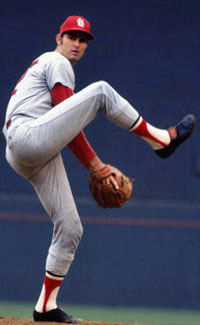
Steve Carlton, Cardinals
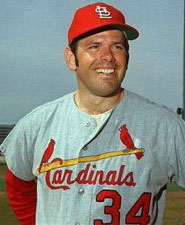
Nelson Briles
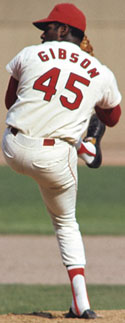
Bob Gibson

August Busch
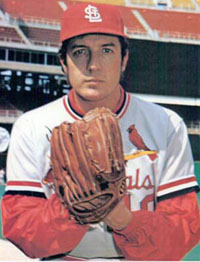
Rick Wise
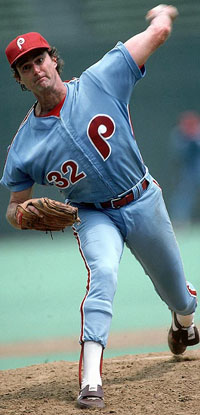
Steve Carlton, Phillies
|
|
|